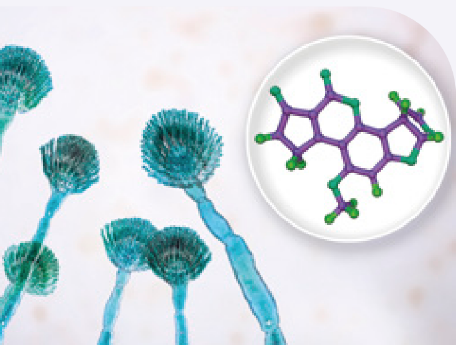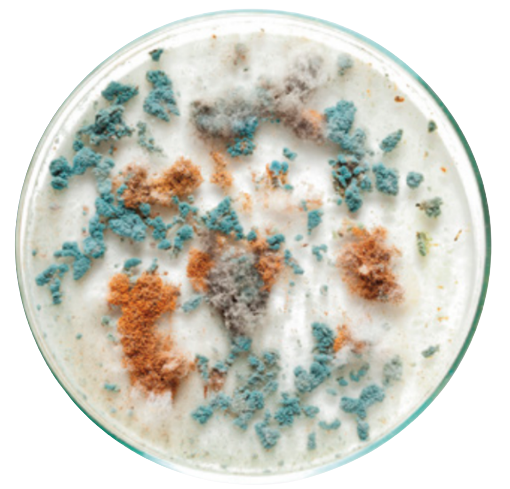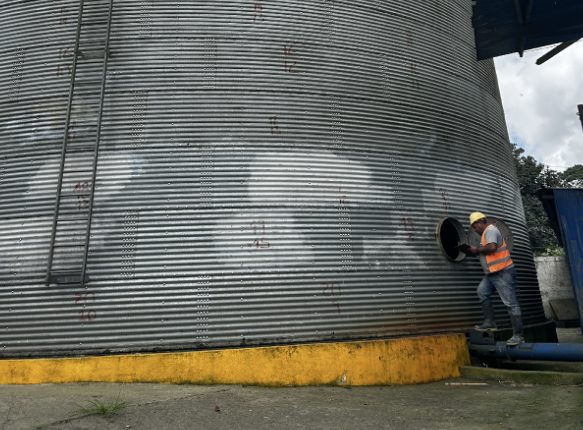 During grain storage, mycotoxins can also develop. Field analyses conducted in Guatemala have shown a significant increase in mycotoxin concentration when proper measures are not taken to prevent fungal growth inside a silo.
During grain storage, mycotoxins can also develop. Field analyses conducted in Guatemala have shown a significant increase in mycotoxin concentration when proper measures are not taken to prevent fungal growth inside a silo.
Prevalent Mycotoxins in Grains and Their Impact on Swine::
Aflatoxins
![]() Produced by Aspergillus fungi both before and during storage, Aflatoxin B1 stands out as the most prevalent and hazardous. It impacts liver function and induces immunosuppression.
Produced by Aspergillus fungi both before and during storage, Aflatoxin B1 stands out as the most prevalent and hazardous. It impacts liver function and induces immunosuppression.
While acute aflatoxicosis is infrequent in pigs, it leads to significant liver impairment, manifesting in symptoms like bleeding, jaundice, and sudden death.
 Image 1: Aspergillus flavus hyphae, upper inset chemical structure of Aflatoxin B.
Image 1: Aspergillus flavus hyphae, upper inset chemical structure of Aflatoxin B.
Vomitoxin
 Also known as deoxynivalenol (DON), produced by Fusarium spp before harvest. Common contaminant in corn, wheat, and DDGS in North America and Europe.
Also known as deoxynivalenol (DON), produced by Fusarium spp before harvest. Common contaminant in corn, wheat, and DDGS in North America and Europe.
It disrupts protein synthesis, influences immune modulation, and impacts neurotransmitter activity in the brain.
Zearalenone
Produced by Fusarium graminearum usually before harvest. Structurally mimics estrogen, affecting the reproductive tract in pigs.
![]() In young sows, zearalenone causes swelling and redness of the vulva, often leading to rectal and vaginal prolapses. In pregnant sows, false pregnancies and early embryo losses occur.
In young sows, zearalenone causes swelling and redness of the vulva, often leading to rectal and vaginal prolapses. In pregnant sows, false pregnancies and early embryo losses occur.
During lactation, zearalenone passes through milk, inducing vulvar swelling and redness in newborn female piglets. In boars, zearalenone suppresses testosterone levels, sperm production, and libido, especially in younger animals.
Fumonisins

Generally cause immunosuppression. Acute toxicity leads to a condition called porcine pulmonary edema, characteristic of fumonisin poisoning, causing heart failure and fluid accumulation in the lungs.
Pigs with acute toxicity exhibit severe respiratory signs, difficulty breathing, cyanosis, and death.
![]() Chronic toxicity results from ingesting small amounts of fumonisins over an extended period, leading to reduced feed intake, slower growth, increased susceptibility to secondary diseases, and a diminished response to vaccination.
Chronic toxicity results from ingesting small amounts of fumonisins over an extended period, leading to reduced feed intake, slower growth, increased susceptibility to secondary diseases, and a diminished response to vaccination.
Ochratoxin
In cases of ochratoxin A toxicity, pigs often have slow growth and poor feed efficiency due to impaired kidney and liver functions.
Feed intake is usually unaffected. In some cases, the only toxicity effect of ochratoxin A is detected at slaughter due to the appearance of pale, firm, and enlarged kidneys.
 Ochratoxin A contamination is also a concern for human health as pork and its derived products may contain potentially carcinogenic residues.(Malagutti et al., 2005).
Ochratoxin A contamination is also a concern for human health as pork and its derived products may contain potentially carcinogenic residues.(Malagutti et al., 2005).
CLASSIFICATION
 Polar mycotoxins have such bonds. When these polar mycotoxins come into contact with clay (aluminosilicates), they form a bond, creating a clay/mycotoxin complex that is not absorbable, and the mycotoxin is eliminated through pig excreta. Polar mycotoxins have such bonds. When these polar mycotoxins come into contact with clay (aluminosilicates), they form a bond, creating a clay/mycotoxin complex that is not absorbable, and the mycotoxin is eliminated through pig excreta. |
The subsequent category of mycotoxins is non-polar. As they lack an electrical charge, clay-based binders prove ineffective. Yeast cell walls, on the other hand, excel in preventing the impact of these mycotoxins.
Mechanisms of Action of Non-Polar Adsorbents:
It’s crucial to note that the effectiveness of yeast cell walls as mycotoxin adsorbents may vary depending on the specific composition of mycotoxins and yeasts used.
 Processing conditions and complex interactions between food or feed components can also influence adsorption capacity.
Processing conditions and complex interactions between food or feed components can also influence adsorption capacity.
 The mycotoxin absorbent industry has evolved in recent years. Enzymes capable of breaking down and transforming mycotoxins into inert products are gaining popularity and revolutionizing mycotoxin inactivation in the pig industry. The mycotoxin absorbent industry has evolved in recent years. Enzymes capable of breaking down and transforming mycotoxins into inert products are gaining popularity and revolutionizing mycotoxin inactivation in the pig industry. |
In vivo, appropriate conditions must be provided for mycotoxin and the binder to adhere or form the binder/mycotoxin complex. A diet should promote physiological elements for this binding to occur.
![]()
When formulating a pig diet, factors such as intestinal movements, gastric emptying, pH variability, and intestinal transit speed should be considered.
 All these factors significantly influence the adhesion between mycotoxins and the binder. If the gastrointestinal transit is poorly modulated, it can lead to a decrease in the absorption capacity of a mycotoxin binder, as shown by in vitro results.
All these factors significantly influence the adhesion between mycotoxins and the binder. If the gastrointestinal transit is poorly modulated, it can lead to a decrease in the absorption capacity of a mycotoxin binder, as shown by in vitro results.
An essential aspect to consider is the absorption and desorption capacity of a binder. Desorption is the binder’s ability to release a percentage of absorbed mycotoxin. A poorly modulated gastrointestinal system can affect the desorption capacity of the binder, releasing mycotoxins.
Another critical aspect when dealing with mycotoxins is to prevent their production during storage. If adequate contingency measures are not in place during this period, the increase in mycotoxins in the silo can be significant and challenging to control.

It should not be forgotten that Latin American countries have favorable conditions (humidity and temperature) for fungal proliferation in stored grains.
Points to Consider During Storage:
Moisture monitoring:
Monitor moisture by season (winter, summer, or cold season). This measurement is crucial because if we turn on the ventilator, and the humidity is high, we are not ventilating the grain but introducing more humidity inside. Therefore, we must identify the time of day when relative humidity is lowest.
Grain temperature:
Identify the grain temperature during the day or night and the season (winter or summer). We aim to inject air into the silo to lower the temperature. It should not be forgotten that a seed is an embryo, and it reacts to the environmental conditions it faces.
Water condensation:
This is a crucial point in cases where the environmental temperature is higher than the interior temperature of the silo. This has an effect on the roof sheet or the silo walls. This clash of temperatures, coupled with the presence of humidity, leads to the condensation of water within the silo structure.
Once this moisture is condensed, the roof and walls will drip water onto the stored grain. It is essential to identify the time of the year when this effect intensifies.

Image 2: Worker overseeing the cleaning and water condensation control before corn enters a silo.

One of the most effective measures for preventing fungal growth during storage is the application of organic acids to the grain as it enters the facility. Acidity efficiently prevents the proliferation of fungi.
Conclusions
|
You also like to read: “Mycotoxin levels in soybean meals”